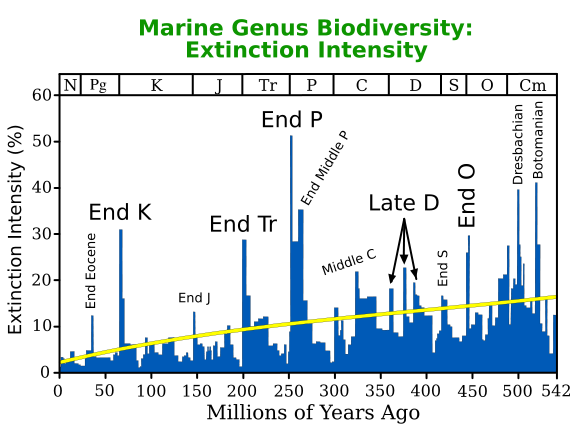The Triassic Period was a gnarly time to be alive on Earth, and not only because it was Act One of the age of dinosaurs. This epoch stretched from 251 to 199 million years ago, and was bookended by mass extinction events caused, in part, by abnormally high atmospheric carbon levels.As a result, Triassic Earth was warmer than the modern world, lacked ice caps at its poles, and saw widespread desertification within the supercontinent Pangaea and wetlands along its coast. It would likely not have been a liveable environment for human beings, even without the threat of Dilophosaurus attacks around every corner.
Advertisement
Unfortunately, we may be headed back there in the near future, according to research published Tuesday in Nature Communications.A team led by Gavin Foster, a professor of isotope chemistry at the University of Southampton, predicts that atmospheric carbon dioxide (CO2) pollution will reach Late Triassic levels—roughly 2,000 parts per million (ppm)—by the year 2250, if humans continue to consume fossil fuels at the current rate.Furthermore, if our civilization decides to really sell itself out by exhausting all conventional and non-conventional fossil fuel reserves, we should expect CO2 levels to rise to a cataclysmic 5,000 ppm by the 24th century, the researchers said. This human-driven "climate forcing," the term for any factor that affects Earth's climate, would be further exacerbated by the slow-but-steady brightening of the Sun over time, which is part of the star's natural life cycle."[B]ecause the Sun was dimmer back then [in the Triassic], the net climate forcing 200 million years ago was lower than we would experience in such a high CO2 future," Foster said in a statement. "So not only will the resultant climate change be faster than anything the Earth has seen for millions of years, the climate that will exist is likely to have no natural counterpart, as far as we can tell, in at least the last 420 million years."

In other words, if humans continue to clog the atmosphere with greenhouse gases, we could create an amplified version of the end-Triassic extinction, also known as the Triassic-Jurassic extinction event, which was catalyzed by noxious gases belched into the atmosphere by volcanic eruptions.
Advertisement
The same process of volcano-induced warming is also thought to have capped off the Permian Period, which directly preceded the Triassic, resulting in the so-called "Great Dying," the most devastating extinction event known to scientists, which killed off 95 percent of life on Earth."The carbon dioxide pumped out by volcanoes [in the Permian and Triassic extinction events] is analogous to the carbon dioxide that we are pumping out as we burn fossil fuels," Steve Brusatte, a paleontologist based at the University of Edinburgh, told me over email. (Brusatte was not involved in the Nature Communications study.)That said, the rate at which humans are producing greenhouse gases, and turning up Earth's thermostat, outpaces the volcanic eruptions that brought about the Great Dying.Read More: After 160 Million Years of Success, Climate Change Killed Ichthyosaurs"That is the sort of thing that keeps me up at night," Brusatte said. "What we are doing may be worse. Rate is the key here. No doubt that the Earth will survive all of the horrible things we are doing to the environment. It always does. It recovered from the end-Permian and end-Triassic volcanoes, and from the asteroid that killed off the dinosaurs."Brusatte's concern is that the Earth is now changing so rapidly that humans won't be able to adapt along with it. "Humans have evolved in concert with a very specific set of conditions on Earth," he said. We are used to a certain range of temperatures, and our urban, agriculture, and transportation systems, along with countless others, are designed with that range in mind.
Advertisement
"For those reasons, I think it would be difficult for humans to thrive if we were magically transported back to the end-Triassic," he said.With American leadership in clean energy effectively hobbled by the Trump administration, which is working to revive the coal industry and gag climate change researchers, these visions of an new end-Triassic—or worse, a Great Dying—are more vivid and relevant than ever.Read more of Motherboard's climate change coverage:
- Goodbye World: We've Passed the Carbon Tipping Point For Good
- On Top of Everything Else, Climate Change Helps West Nile Disease to Spread
- Climate Change Is Turning Canada into Margaritaville
- The Bizarre Chain of Events That Led to an Unusual Number of Ticks This Summer
- Antarctica's Disintegration Could Actually Lead to a Hollywood Disaster Scenario
